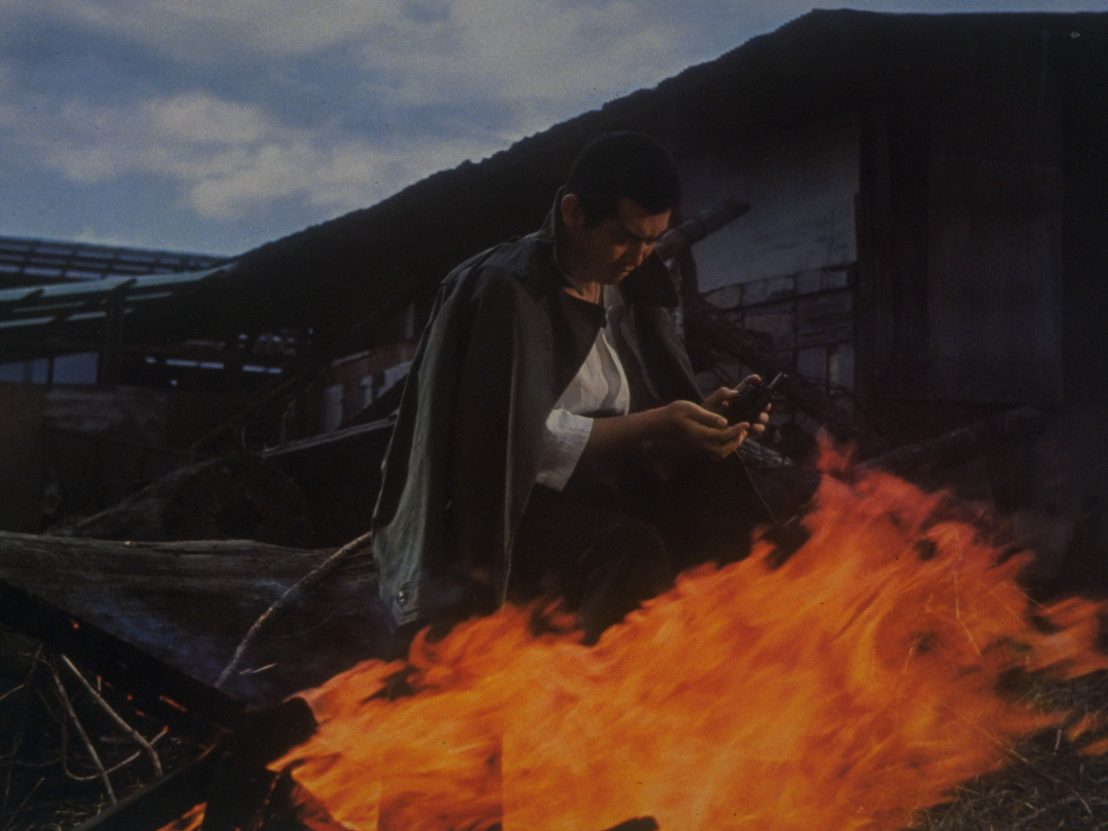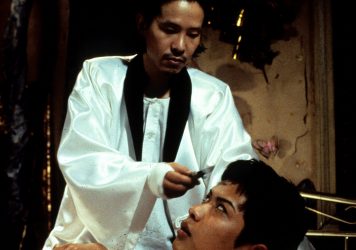
“Rikio Ishikawa, the hero of this film, was born in Aug 6, 1924.” So reads the text that opens Kinji Fukasaku’s Graveyard of Honor, as we see black-and-white photographs from the very real Ishikawa’s childhood, and hear interviewees comment on how he was a constant crybaby, how “he was different from the others”, how he had “a hard core to him”, and how he “always wanted to be a yakuza” (a line which appears to have influenced Martin Scorsese’s 1990 gangster biopic Goodfellas). Finally someone comments, “What made him turn into a mad dog? It wasn’t the war. He was just crazy.”
This introduction establishes that Graveyard of Honor belongs to the same subgenre – Jitsuroku eiga, literally ‘actual record films’ – that Fukasaku had first popularised with his Battles Without Honor and Humanity and its various sequels. Unlike the earlier Ninkyo eiga (‘chivalry films’) which glorified the chivalry and codes of honour among prewar yakuza or their predecessors the bakuto, these newer gangster films dramatised the thuggery and dishonour of postwar yakuza in a style akin to documentary, even drawing their stories from real life.
Ishikawa (Testuya Watari) may be this film’s ‘hero’ in the sense that he is its constant focus, but he is far from an exemplary figure. On the contrary, he is impulsive and aggressive, appetitive and entitled. While the violence and chaos that he brings may emblematise the profound winds of change that swept through Occupied Japan in the immediate aftermath of World War Two, this trouble-making protagonist beats, rapes and kills with unrestrained abandon, in the end biting every hand that feeds and burning every bridge behind him. He is the ultimate rebel without a cause, fighting friends as well as enemies, and destroying everyone around him – and eventually himself – with his arbitrary onslaughts and later his heroin addiction.
One of the interviewees in the film’s introduction had said of Ishikawa: “When I was doing time with him, he once said he was like a balloon. Meaning he’d keep rising higher until finally he’d burst.” Balloons will occasionally appear in the film, as recurrent reminders of this prefatory image, but in a sense Graveyard of Honor is less about the rise of Ishikawa’s balloon than its implosive collapse in slow motion. His final suicide, a plummet from the roof of a prison building, encapsulates in a single scene this character’s trajectory from the start.
As his unpredictable, destructive actions leave bewildered those members of the old guard whom he does not outright kill, Ishikawa shakes up and burns down the system in which he has spent his traumatic formative years, even if he is incapable of offering a constructive model for what might be rebuilt from the ashes. Accordingly, the film’s final wide shot of construction works in Tokyo can come only after the scene of Ishikawa’s death.

Where Graveyard of Honor is a period film looking back from the mid ’70s to the late ’40s, Takashi Miike’s 2002 remake Shin Jingi no Hakaba (literally ‘New Graveyard of Honor’) is updated to contemporary times. And while it does not requote the line from Fukasaku’s film about the bursting balloon, that line still resonates in a film whose protagonist’s early rise and gradual, spiralling fall are made to frame the bursting of Japan’s asset price bubble in 1991.
Rikio Ishikawa was a real person whose life and death is reconstructed in Fukasaku’s film, but in Miike’s reimagining, set some four decades after the real Ishikawa met his end, the protagonist – now minimally renamed Rikuo Ishimatsu (Goro Kishitani) – is closer to myth than reality, and transforms, as the film goes on, into a demonic figure. Yet in his final moments, with which the film opens as well as closing, the cape-like blanket in which he wraps himself atop a prison tower may make him resemble a superhero, but does not lend him commensurate powers of flight, so that he is ultimately bound at least to the reality of gravity.
In his early twenties, in the film’s earliest chronological scene, Ishimatsu is rapidly elevated from lowly dishwasher to made man after he intervenes to save yakuza godfather Sawada (Shingo Yamashiro) from an attempt on his life. Resented as an upstart by the other members of Sawada’s gang, Ishimatsu wins Sawada’s admiration for his efficiency as an attack dog. But this criminal ‘yuppie’ will become a liability once Japan’s bubble has burst. For his mercurial temper and driven rapacity create bloody mayhem wherever he goes, and repeatedly cause him to turn on his closest allies, even as his excessive rampages coincide with Japan’s ‘lost decade’ of economic stasis.
In case the national allegory is missed, in a scene where Ishimatsu has taken some of his former colleagues hostage, and murdered others, to achieve his ill-defined ends, he is shown draped in the Japanese flag. For he is an embodiment of the immense damage for the country in that period of stagnation, where downsizing, despair and destruction ruled all.
This is what makes both versions of the film so fascinating: the way in which they take this juggernaut of a character and let him run riot through two very different periods of crisis in Japan’s history. Yet what unites them is their narrative commitment to a repellent character with few if any redeeming features. The man at the centre of both these films is a living incarnation of toxic masculinity – even if that term did not yet even exist when Fukasaku made his version. Serially raping his ‘wife’ and shooting, stabbing and clubbing his comrades at arms, he is on a nihilistic, narcissistic dash upwards that is simultaneously a race downwards, and he brings near everyone whom he encounters crashing with him.
Near the end of Fukasaku’s film we learn that Ishikawa had written the words “What a laugh! Thirty years of frenzy!” on his cell wall shortly before taking his final plunge – a graffito that turns his wild exploits into a joke, and him into an anarchic Joker. In Miike’s version, the joke is on him, as a cynical coda to Ishimatsu’s death shows the surviving old guard getting right back to business as usual, while the younger generation is still paying the price in missing fingers and jail time. For all the sound and fury of this lone wolf’s frenzied reign, his rebel yell has fallen silent as soon as it was raised, and nothing has changed.
Graveyards of Honor is available in a two-disc Blu-ray set from Arrow Video, containing both Fukasaku’s and Miike’s versions, from 7 September.
Published 7 Sep 2020

By Anton Bitel
Shinya Tsukamoto’s Fires on the Plain is a harrowing reminder of the futility and madness of human conflict.

Japan’s Takashi Miike is running on creative vapours in this tiring knockabout genre mash-up.

The ’90s straight-to-video boom reinvigorated the industry and made stars of directors like Takashi Miike.